Cable Arm Exercises: Triceps and Biceps (with Pictures!)
While most can imagine an ideal arm workout that includes nothing but free weights, cable machines provide a proven alternative and serve as an excellent accompaniment to any weight training program.
Exercises that utilize the cable machine include cable curls, bayesian curls, tricep cable pushdown, and overhead tricep extension, among others.
Although the choice of strength training equipment is largely determined by a person's preferences, training goals, and workout program design - the unique advantages of cable machines warrant serious consideration for inclusion in one's arm exercise routine. In addition, cable machines are meant to complement an individual's free-weight training routine and not replace them.
Biceps-Focused Cable Arm Exercises
1. Standing Cable Curls
This arm exercise can be performed using different grips and cable attachments depending on which biceps head or muscle an individual wishes to isolate.
For example, one can use a rope handle, an EZ cable bar, a V-bar, a multi-grip cable bar, or a straight cable bar and choose whether to utilize a pronated, neutral or supinated grip.
They may also cycle between a narrow or close grip on the bar.
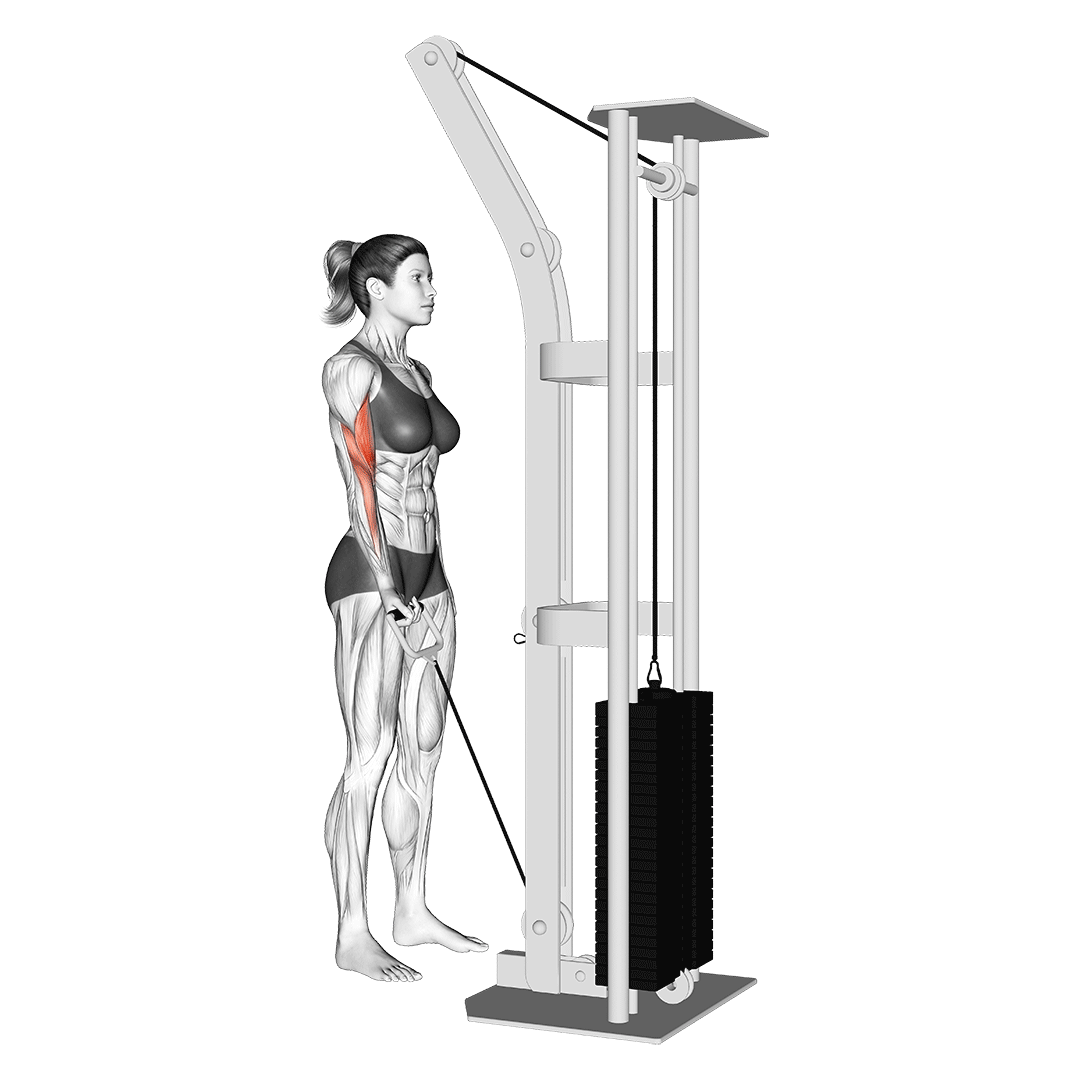
Common mistakes by beginners when performing cable curls are to stand directly over the pulley by which the cable originates or facing away from the cable machine with the cable originating from the back of the heels of the feet.
The effect would be like doing curls with free weights where there is little to no resistance at the top of the motion for the biceps.
Attach any bar or handle to the cable and grab the bar or handle with both hands using any grip of choice. Adjust the cable machine, so the pulley is at its lowest placement on the tower.
Stand facing the machine with feet shoulder-width apart and the toes about a foot away from the pulley. Curl the bar up to the top while keeping the elbows' position locked.
Hold for a second, then slowly lower down until the arms are straight.
Repeat the movement for the desired number of repetitions.
2. Inclined Cable Curls
According to a study by Oliviera et al., when executing this exercise, the biceps' long head remains active during the entire motion.
Furthermore, the long head is stretched as the arms hang behind the body on an inclined bench, providing maximal force during the action.
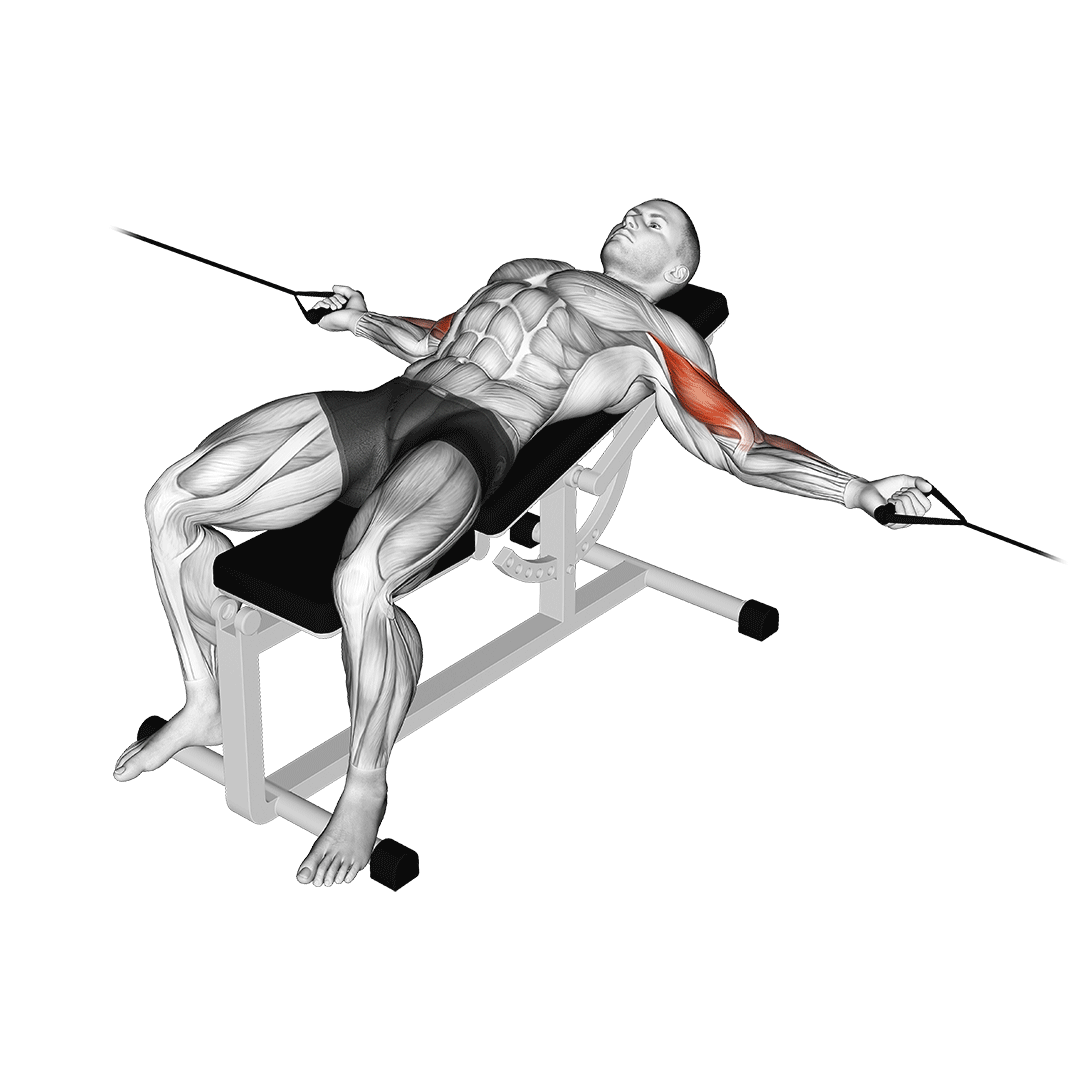
Place an inclined bench between two cable machines and adjust the bench's backrest to a 45-60 degree angle.
If there is discomfort in the shoulder joints, raise the bench to a greater angle. Connect D-handles to both ends of the cables. Sit back and hold a D-handle in each hand with a supinated grip.
Pull the handles towards your chest while maintaining the same elbow posture throughout the ROM.
Then, reverse the action until your hands are back at the starting position.
Repeat.
3. Bayesian Curls
Connect a D-shaped handle to a cable machine.
Grab the handle with an underhand grip and take a step forward into a split stance with your back to the pulley for improved balance. When dealing with heavier weights, this stance will aid in stability.
With the arm extended, the elbow should be behind the torso.
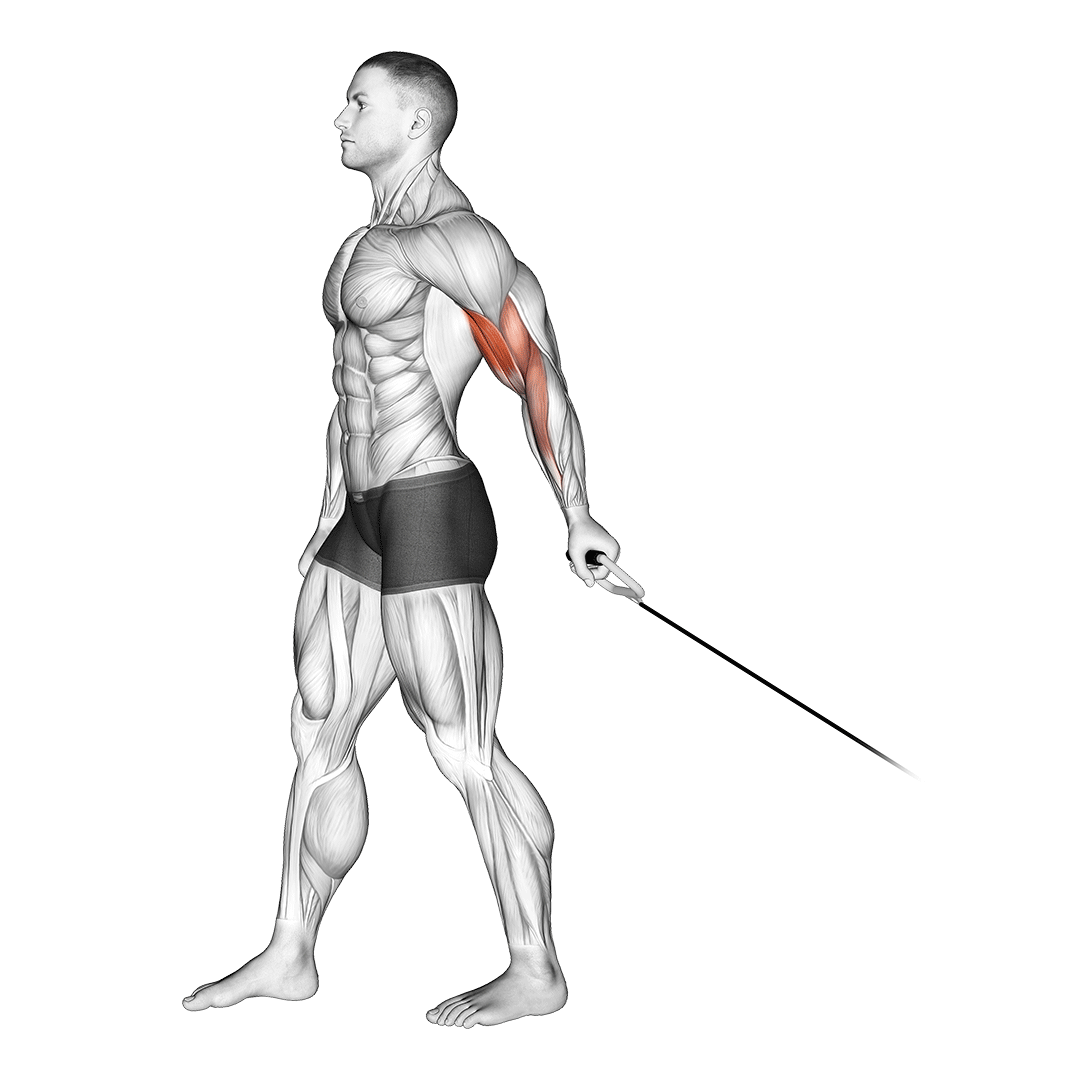
Bring the handle up to shoulder height by bending your elbow while keeping its position behind the body. Next, extend your arm down and back.
Repeat; Do the same number of sets and reps on the other arm.
4. Overhead Cable Curls
This is another excellent option for targeting the biceps.
Attach D-shaped handles on each cable, then adjust the pulleys to be about the height of your head.
To perform this workout, stand in the center of two cable machines. Hold a handle in each hand, arms straight, palms up, and Inhale deeply and tighten the core.
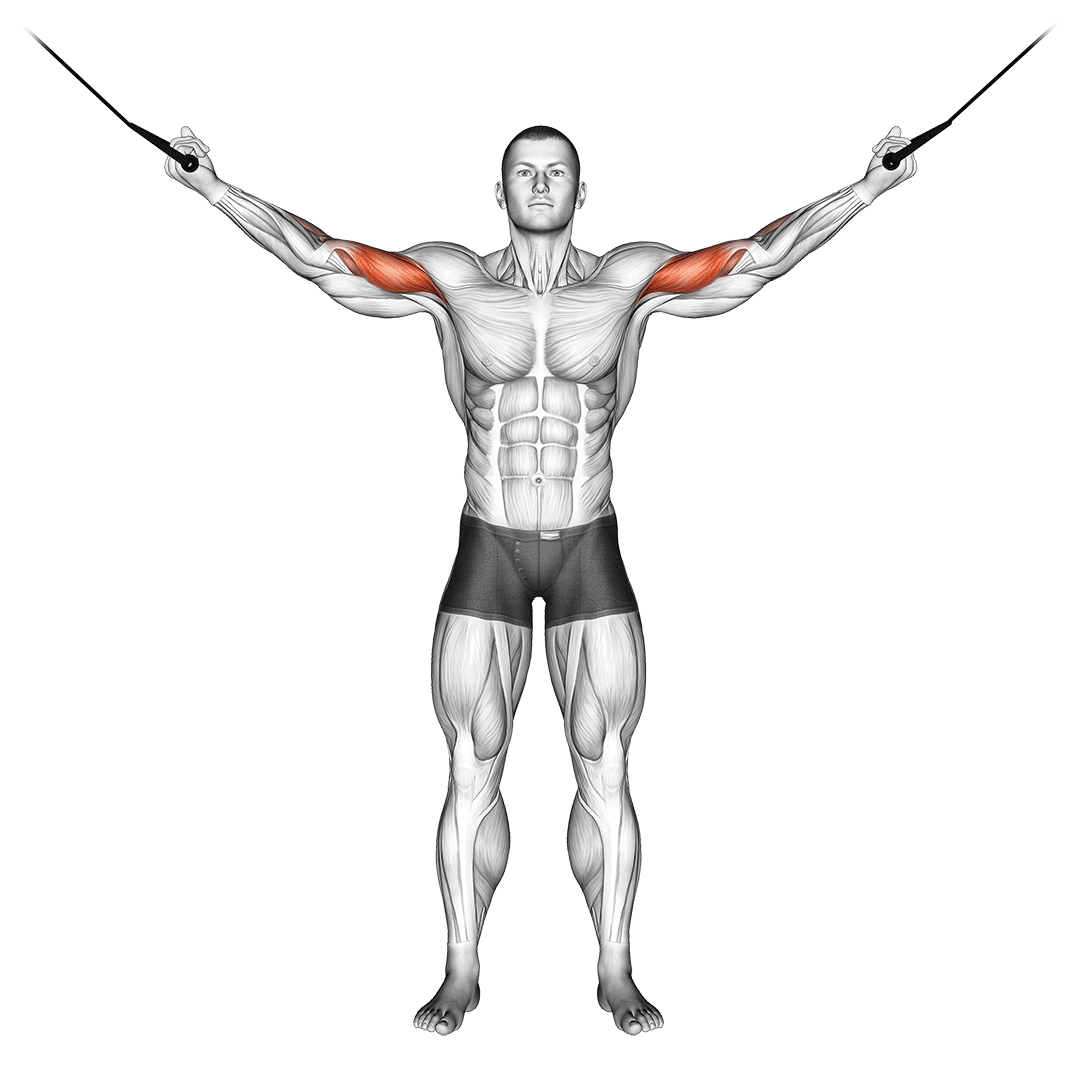
Pull the handles in toward your shoulders by bending the elbows. Keep the wrists straight and squeeze the biceps when the elbows are flexed.
Then, return to the starting position by extending the arms slowly.
5. Preacher Cable Bar Curls
An adjustable angle preacher bench would be ideal for this exercise to benefit from increased biceps activation at 75° shoulder flexion.
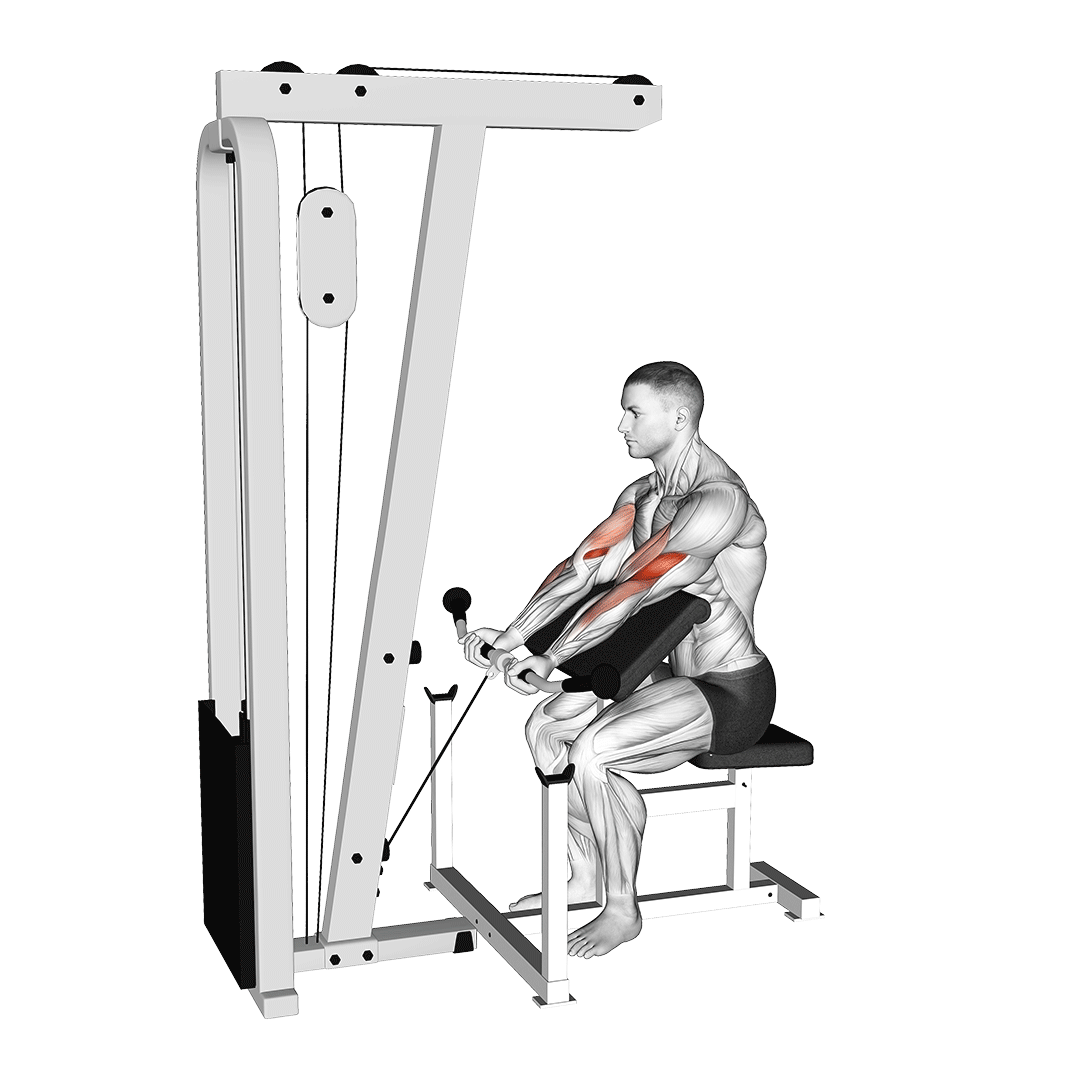
Adjust the preacher bench, so the shoulder flexion is at a 75° angle.
Attach any bar or handle to the cable and hold it with both hands using your preferred grip (like the standing cable curl). Pull the bar gently towards the shoulder, hold for a second, and squeeze the biceps.
Then, reverse the action to the starting position and repeat the movement for several repetitions.
Triceps-Focused Cable Arm Exercises
1. Triceps Cable Pushdown
Attach any bar or handle to the cable and grasp the bar or handle with both hands using any grip of choice.
Depending on the triceps head a person wishes to isolate, this arm exercise may be performed utilizing several types of grips and cable attachments.
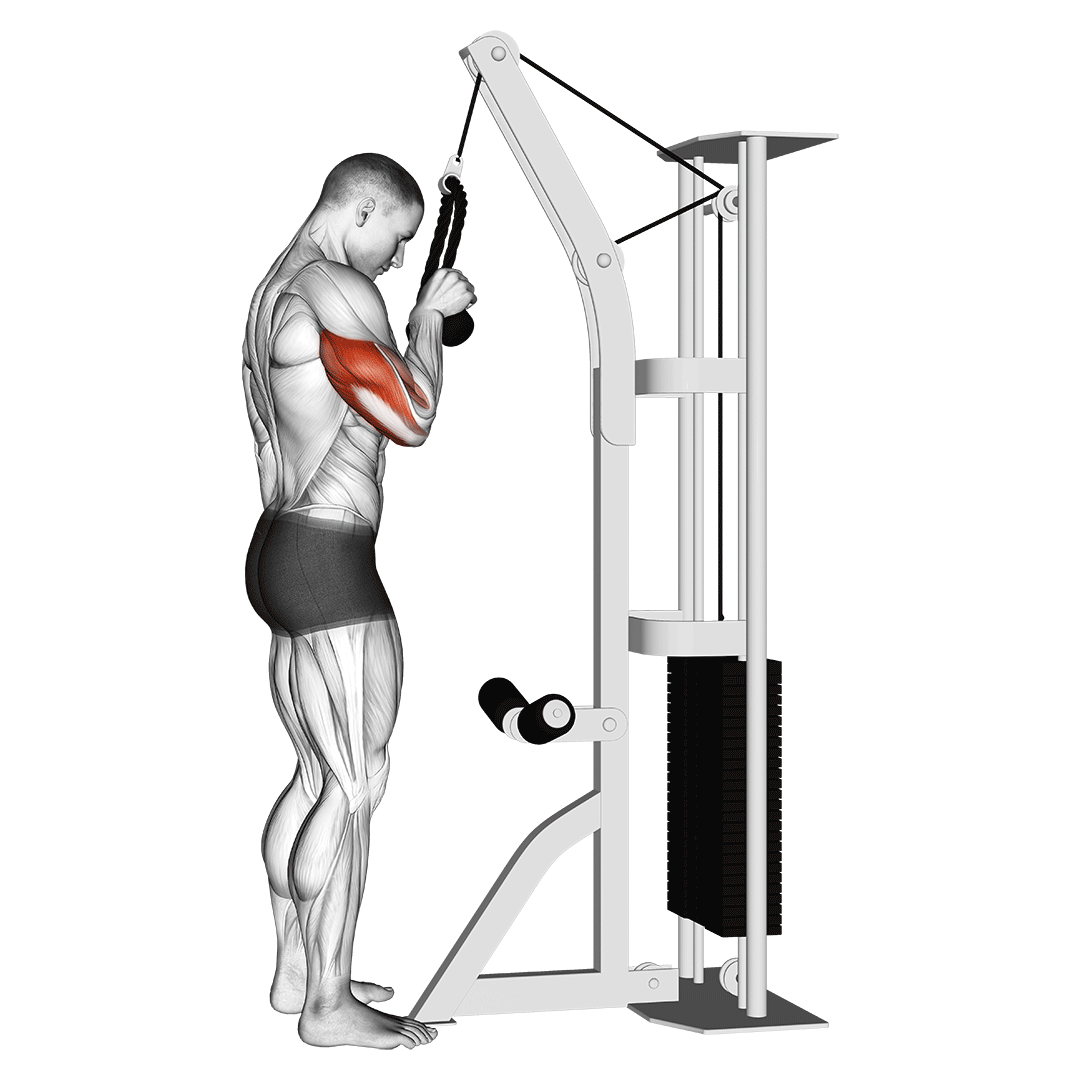
For example, one may use a rope handle, an EZ cable bar, a V-bar, a multi-grip cable bar, or a straight cable bar, and the grip can be pronated, neutral, or supinated.
One can also alternate between a narrow and a close hold on the bar.
Attach a handle of your choice to a cable station's high pulley. Keep the elbows tucked in at the sides of the body. Grab the handle, brace the core, and lower the hands until the arms are completely extended.
Return to the starting point.
Repeat for the desired number of repetitions.
2. Overhead Rope Tricep Extension
Connect a rope to the cable machine's bottom pulley. Grab the rope handles using a neutral grip, face away from the machine and extend the arms with the hands over the head.
The elbows should be close to the head throughout the ROM.
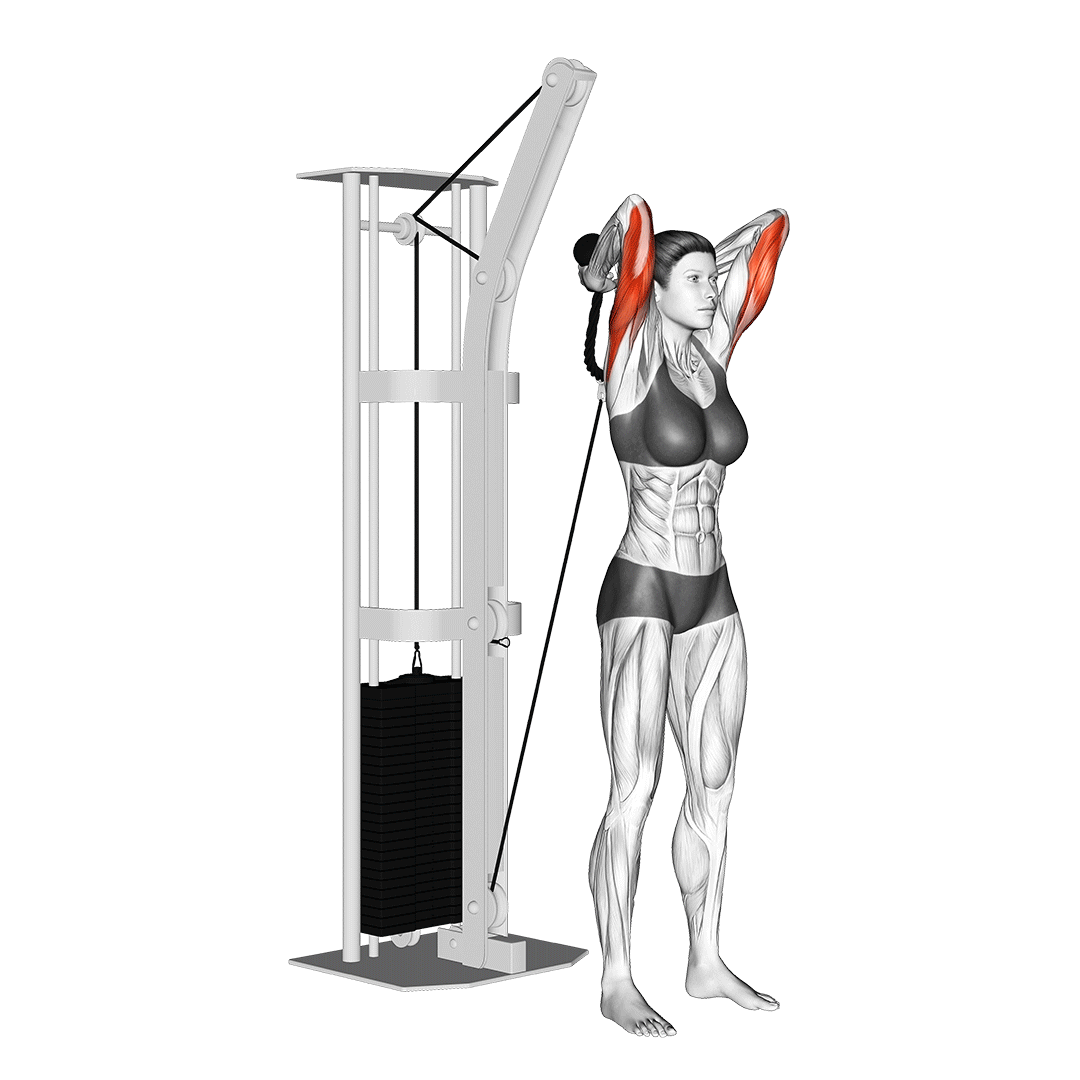
Slowly lower the rope behind the head while keeping the upper arms still. Perform this action while inhaling and pausing when the triceps are fully stretched.
Return to the starting position by exhaling while extending the arms.
Repeat for the desired number of times.
3. Supine Tricep Cable Extension
Lie on a flat bench and use a narrow overhand grip to hold the straight bar attachment of a low pulley cable machine. Position the bar above your torso with your arms outstretched.
The angle formed by your arms and torso should be 90 degrees.
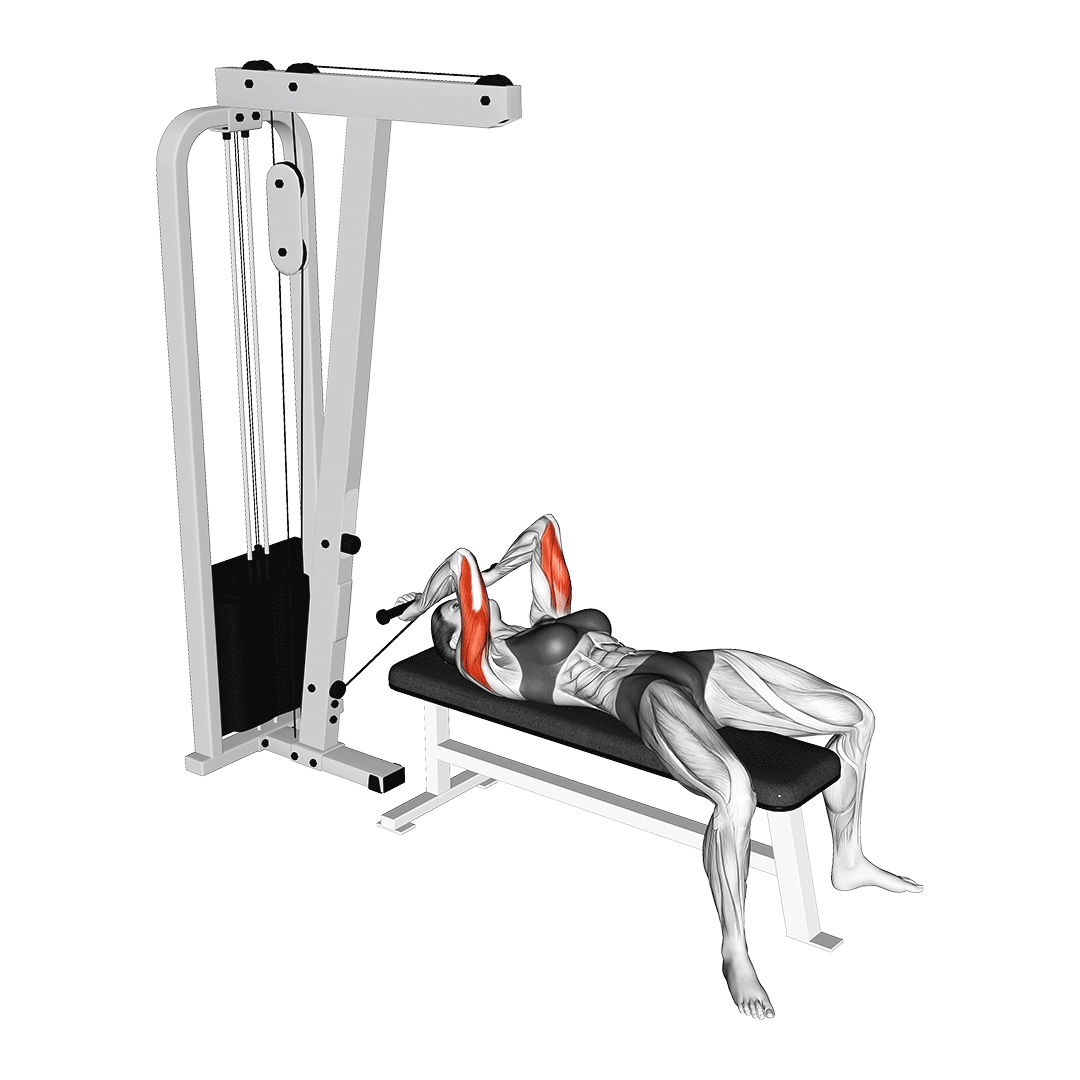
Lower the bar by bending your elbows while maintaining the position of the upper arms and elbows. Lower the bar till it gently touches the head. Flex the triceps while lifting the bar to the starting position.
Repeat for the recommended number of repetitions.
Free Weights vs Cable Machines
When selecting the ideal gym equipment for any exercise regimen, there are numerous variables to consider.
Nonetheless, this article does not get into which is better between free weights and cable machines for arm exercises. Instead, it discusses their benefits and disadvantages to identify the weak points in our training regimen and the need to include both devices in one's training routine.
Free Weights: Pros and Cons
More Functional and More Muscles Recruited
Free-weight arm exercises are considered more functional because they lack stability in their movement path. In addition, they require more coordination in the arm muscles, resulting in more recruitment of the stabilizer muscles to provide support during execution.
The effectiveness of a free weight exercise is due to its role in increasing the output of not just the arm's primary muscles but also the smaller helper muscles.
These stabilizer muscles must work with the prime movers to ensure proper movement and joint alignment, replicating functional movements in daily activities and sports.
Relatively Inexpensive yet More Versatile in Application
Free weights are more common in gyms than cable machines since they take up less space and are less expensive. They can be utilized to target any muscle in the body and have very few limitations in application.
Mechanical Tension Inconsistency
The tension varies significantly from the motion's bottom, middle, and top position when using free weights in arm exercises like biceps curls.
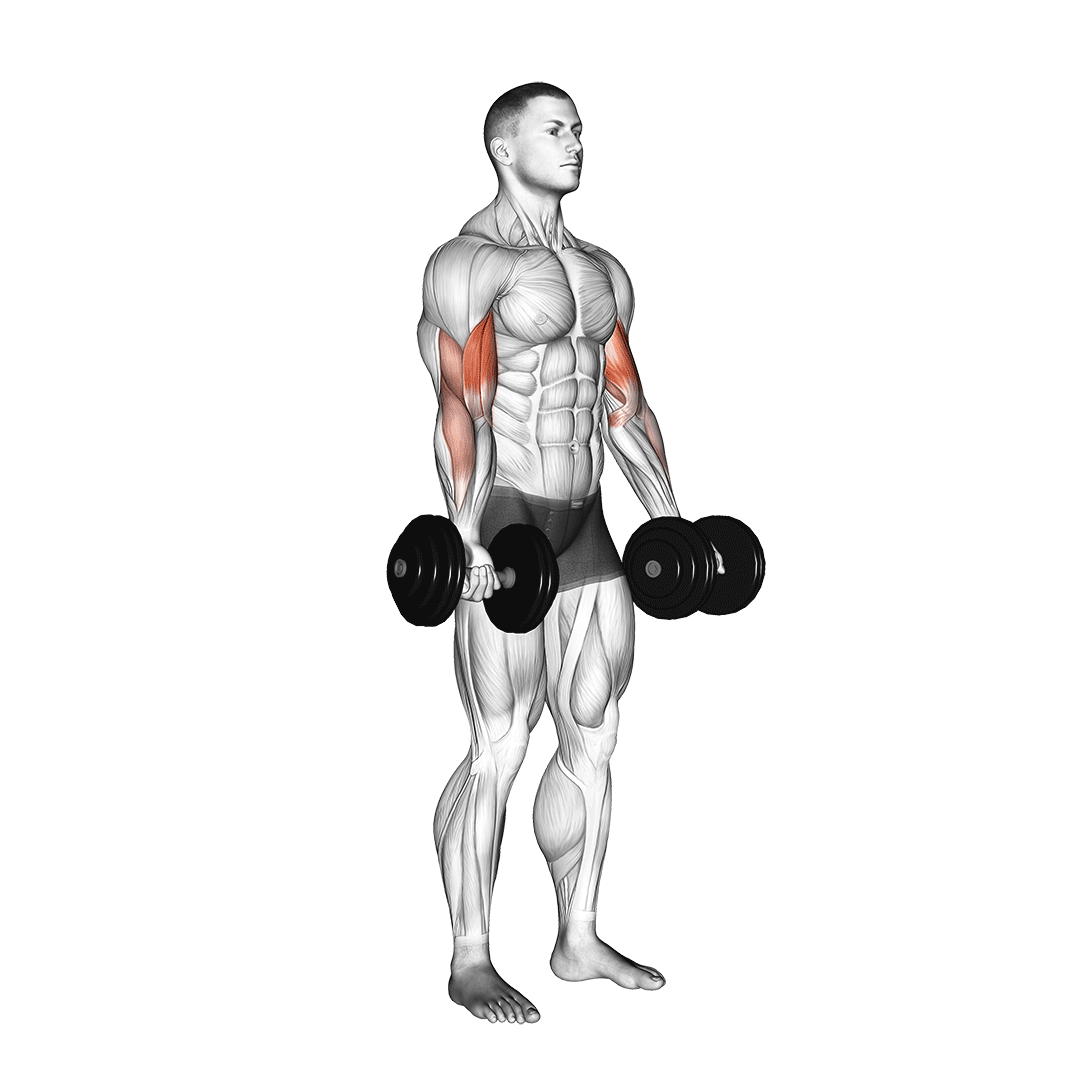
At the top of the curl, the biceps contraction is way less than in the other two positions, while at the middle of the curl, muscle contraction is much higher than in the other two.
Not Beginner-Friendly
Due to the free weight's unstable nature, especially in exercises where the fulcrum is at the bottom, such as single-arm triceps extension, it would be difficult for beginners to take control of the weight in a steady path of movement.
We've all seen this when a beginner sways the dumbbell side-to-side when executing a shoulder press or a single-arm overhead triceps extension.
Greater Risk of Injury
According to a study published by the American Journal of Sports Medicine, machines may be considered safer than free weights, especially given that over 90% of injuries were related to using free-weight devices.
Cable Machines: Pros and Cons
Mechanical Tension Consistency
The fundamental distinction between a cable machine and a free-weight device is that the former provides constant tension at all angles of the exercise's range of motion.
For example, muscle activation is always most significant at the bottom or halfway through the movement when using free weights for arm exercises; It gradually decreases as the weight moves closer to the top.
More Significant Muscle Activation Throughout the Range of Motion (ROM)
Due to the constant tension cable machines provide, there is consistent muscular activation throughout the ROM. As a result, cable machines deliver more significant strength gains and muscular growth since they provide greater muscular activation at any angle of the ROM.
Injuries Due to Overexertion
The sense of security afforded by machines may lead some people to take on far higher loads than they are accustomed to in their training routine.
This overestimation may explain why people who exercise on machines have a higher rate of overexertion injuries. To minimize overexertion injuries, moderate load progressions should be practiced at all times.
Tips for Better Muscle Activation
The following suggestions can be used for better muscle isolation or activation when doing exercises using the cable machine.
Biceps Brachii
Use a preacher curl adjusted at a 75° angle for better activation. in a study by Moon et al., it was discovered that the biceps exhibited the most significant resultant force at a shoulder flexion angle of 75°.
As a result, they concluded that when performing biceps curls on a cable machine, the shoulder should be flexed at a 75° angle to maximize the movement's focus on the biceps.
Long Head Biceps
Use a neutral grip or hammer grip with the hands positioned closer together as in a narrow grip. Curl with elbows behind the body (drag curls, inclined curls, or bayesian curls).
Use a rope handle to start a curl with a neutral grip and supinate slowly at the top of the motion until the pinky sits higher than the thumb.
Short Head Biceps
Use a wide grip on the bar with the forearms supinated as in an underhand grip. Rotate the shoulder outward and curl with arms lateral to the body.
Brachialis
The brachialis can be better activated by using a pronated or overhand grip on the bar.
Triceps Long Head
When doing tricep cable arm exercises, the long head of the triceps has better activation with the shoulder flexed at 90-180°(upper arms front to the body and parallel to the floor or overhead).
Triceps Lateral Head
To emphasize the lateral head of the triceps, use a pronated or overhand grip while keeping the elbows at the side.
Triceps Medial Head
The medial head of the triceps has better activation with a supinated or underhand grip with elbows at the side.
Final Thoughts
Though free weights are preferable for most exercises in that they promote the recruitment of more muscles to stabilize and control not just the load being moved but also the path of the movement, they fall short in maintaining mechanical tension consistency across the range of motion.
This is where cable machines excel, especially when it comes to arm exercises like the biceps curl or triceps extension.
References
1. Kerr ZY, Collins CL, Dawn Comstock R. Epidemiology of weight training-related injuries presenting to United States emergency departments, 1990 to 2007. The American Journal of Sports Medicine. 2010 Apr;38(4):765-71.
2. Moon J, Shin I, Kang M, et al. The Effect of Shoulder Flexion Angles on the Recruitment of Upper-extremity Muscles during Isometric Contraction. J Phys Ther Sci. 2013;25(10):1299-1301. doi:10.1589/jpts.25.1299
3. Jarrett CD, Weir DM, Stuffmann ES, Jain S, Miller MC, Schmidt CC. Anatomic and biomechanical analysis of the short and long head components of the distal biceps tendon. J Shoulder Elbow Surg. 2012;21(7):942-948. doi:10.1016/j.jse.2011.04.030
4. Oliveira LF, Matta TT, Alves DS, Garcia MA, Vieira TM. Effect of the shoulder position on the biceps brachii emg in different dumbbell curls. J Sports Sci Med. 2009;8(1):24-29. Published 2009 Mar 1.
